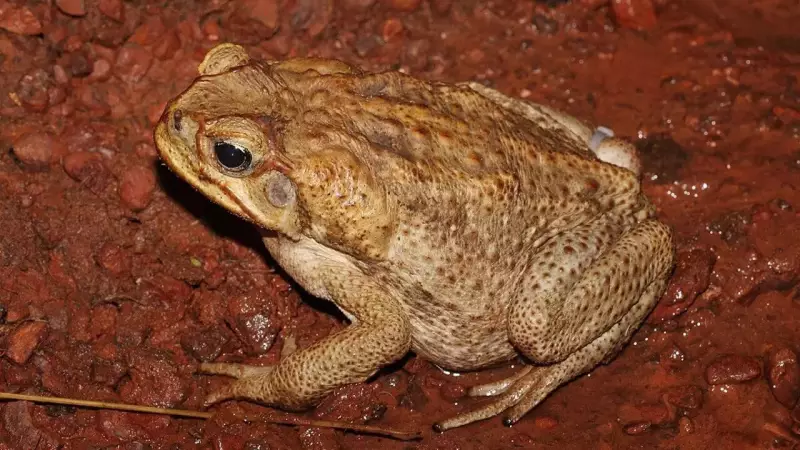
The Rhinella marina, commonly known as the cane toad, stands as one of the most successful invasive amphibians globally, creating ecological havoc across multiple continents. Originally from Central and South America, this formidable creature has demonstrated remarkable adaptability, colonizing territories far beyond its native habitat.
The Unintended Consequences of Human Intervention
In 1935, Australian authorities introduced cane toads to control beetle pests threatening sugar-cane plantations. Instead of solving the pest problem, these amphibians launched an unprecedented invasion, spreading rapidly throughout Queensland and neighboring states. Similar scenarios unfolded across the Caribbean and various Pacific islands, where the toads established dense populations that dramatically altered local ecosystems.
The species' incredible reproductive capacity, combined with its ability to adapt to diverse climates and defend itself with powerful toxins, has made it a textbook example of invasive species success. Today, the cane toad serves as a stark reminder of how human attempts to manipulate nature can backfire spectacularly.
Anatomy of an Invader: Physical Characteristics
Cane toads rank among the world's largest toad species, with adults typically measuring between 10 to 20 centimeters in length, while exceptional specimens can exceed 23 centimeters. Their bodies are stout and heavy-set, featuring short limbs that limit their agility compared to other frog species.
The toad's skin appears dry and covered in wart-like bumps and ridges, with coloration varying from olive-brown to reddish-brown or yellowish-tan, often marked with darker blotches. The underbelly displays lighter shades, typically creamy or pale yellow, sometimes featuring darker patches.
One of the species' most distinctive features is the pair of parotoid glands located behind the tympanum (external ear). These glands secrete bufotoxins—chemicals potent enough to deter or kill predators unfamiliar with them. Juvenile toads generally exhibit darker coloration, smoother skin, and smaller glands, making them slightly less toxic, though still highly successful invaders.
Survival Secrets: What Makes Cane Toads So Resilient
The cane toad's invasive success stems from its potent chemical defenses and remarkable physiological flexibility. The bufotoxins released from their parotoid glands render them nearly untouchable in regions where native wildlife lacks natural resistance.
Beyond their toxic arsenal, these amphibians demonstrate extraordinary tolerance to environmental extremes. They can survive substantial dehydration, adapt to diverse temperature ranges, and quickly adjust to novel habitats. Scientific research reveals that cane toads produce elevated levels of stress hormones and heat-shock proteins when facing challenging conditions, enabling them to endure heat, cold, and dryness.
Observations of Australian populations at invasion frontlines show morphological changes, including longer legs and enhanced endurance, allowing faster dispersal and colonization of new territories. These combined traits create an exceptionally resilient and mobile species capable of rapid global spread.
Ecological Impact and Dietary Habits
Cane toads are opportunistic feeders with diets encompassing insects, spiders, small vertebrates, carrion, and even human food scraps in urban areas. A detailed study conducted in southwest Florida demonstrated that adult cane toads consume wide varieties of arthropods and adjust their feeding behavior according to seasonal prey availability.
This dietary flexibility enables them to thrive in multiple habitats, from suburban gardens and farmland to roadsides and wetlands. Their generalist feeding habits have serious ecological consequences, as they consume native prey and compete with local predators, disrupting food webs and reducing populations of native species.
The toads' ability to exploit virtually any available food source represents a key factor behind their success as invasive species. Their presence can alter invertebrate community compositions and create cascading effects throughout ecosystems.
Global Spread and Habitat Preferences
Originally confined to tropical and subtropical regions of Central and South America, cane toads have now established populations in more than 20 countries across diverse environments. Their invasion success relies on multiple traits: high reproductive output, generalist diet, chemical defenses against predators, and climate tolerance.
Predictive models suggest that under "do-nothing" scenarios, cane toads could colonize nearly entire regions where they've been introduced. The ecological consequences have been profound: native predators often die from ingesting toxic toads, while native species face intensified competition for food and habitat.
These amphibians have demonstrated extraordinary adaptability by occupying disturbed habitats including suburban areas, drainage ditches, farmland, and dry woodlands. This combination of factors has solidified their reputation as one of the world's most successful and destructive invasive vertebrates.
Ongoing Concerns and Conservation Implications
The cane toad exemplifies the ecological risks posed by invasive species. Its rapid population growth, broad dietary habits, and capacity to colonize diverse habitats continue to disrupt native ecosystems, threatening wildlife that lacks natural resistance to its toxins.
The species demonstrates the long-term impacts of introducing non-native organisms for pest control and highlights the difficulties in managing established invasive populations. Researchers continue studying its behavior, diet, and spread patterns to develop more effective conservation strategies.
Understanding cane toad biology remains essential for protecting ecosystems in invaded regions and preventing future invasions in vulnerable habitats. The ongoing scientific investigation aims to mitigate the damage caused by this remarkably successful invader and inform future decisions regarding species introduction.





